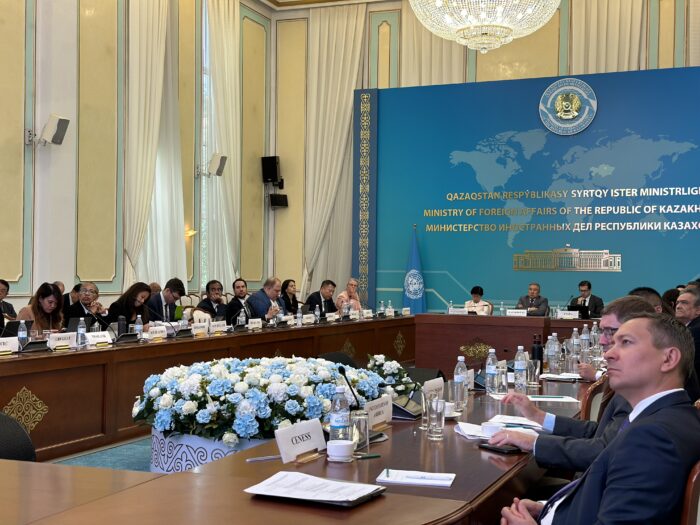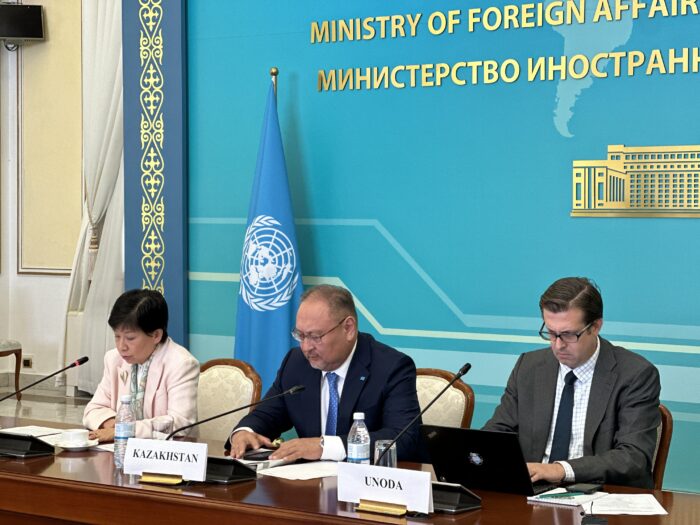ASTANA—Kazakhstan hosted a pivotal workshop that kicked off on Aug. 27, gathering experts and officials from around the world to revitalize the five existing nuclear-weapons-free zones (NWFZs) and enhance cooperation among them.

Kazakhstan, in collaboration with the United Nations Office for Disarmament Affairs (UNODA), hosted a pivotal workshop that kicked off on Aug.27. Photo credit: The Astana Times/ Nargiz Raimbekova
The event, organized in collaboration with the United Nations Office for Disarmament Affairs, is held ahead of the International Day against Nuclear Tests on Aug. 29.
“The zones, which cover over half of the world’s land mass, represent the belief held by the majority in the world that not possessing nuclear weapons is actually in their security interests,” said Izumi Nakamitsu, the Under-Secretary-General and High Representative for Disarmament Affair, addressing the event.

From left to right: Izumi Nakamitsu, Akan Rakhmetullin and Christopher King. Photo credit: The Astana Times/ Nargiz Raimbekova
In his opening remarks, Kazakhstan’s First Deputy Minister of Foreign Affairs, Akan Rakhmetullin, noted the importance of strengthening ties between NWFZs.
“Our agenda includes discussions on measures to sustain and strengthen the effective cooperation among existing zones, including potential communication and information-sharing mechanisms,” said Rakhmetullin. He highlighted Kazakhstan’s ongoing commitment to nuclear disarmament, recalling the closure of the Semipalatinsk nuclear test site and the establishment of the Central Asian NWFZ.
Addressing challenges, strengthening global commitment to NWFZs
The workshop, the first of its kind in five years, addressed the challenges faced by NWFZs, including the need for better communication, dynamic cooperation and encouraging nuclear-armed states to adhere to treaty protocols. The participants agreed that, as nuclear threats grow, the workshop’s outcomes could be crucial for shaping international security and peace.
Tariq Rauf, an independent consultant and former head of Verification and Security Policy at the International Atomic Energy Agency (IAEA), noted that NWFZs face significant challenges regarding security assurances. Nuclear-armed states have only provided conditional assurances, promising not to use nuclear weapons except under certain circumstances. This created a gap that needs to be closed to ensure proper security for these zones.

Tariq Rauf, an independent consultant and former Head of Verification and Security Policy at the International Atomic Energy Agency (IAEA). Photo credit: The Astana Times/ Nargiz Raimbekova
“What we really need are internationally legally binding security assurances, and at the moment, we do not have them. Meetings like this are vital for making the case,” said Rauf.
He also pointed out that NWFZs have faded from global focus, stressing the importance of such meetings to reinvigorate attention and support for five existing zones.
Additionally, experts suggested creating a centralized council to improve consultations among the zones.
Christopher King, chief of the Weapons of Mass Destruction Branch at UNODA, presented a plan to utilize a UN platform for NWFZs to provide member states with centralized access to events, treaties and crucial information. The participants noted that this platform could serve as a comprehensive hub, integrating multilingual support and AI-generated translations to improve outreach and education.
Kazakhstan’s legacy in nuclear disarmament
Kazakhstan’s commitment to nuclear disarmament began with the closure of the Semipalatinsk nuclear test site on Aug. 29, 1991, and its voluntary renunciation of the world’s fourth-largest nuclear arsenal. The country’s efforts include establishing the Central Asian Nuclear-Weapon-Free Zone and the initiative to designate Aug. 29 as the International Day Against Nuclear Testing in 2009 by the UN.
“Kazakhstan’s leadership on nuclear weapon-free zones, particularly in establishing the Central Asian zone, is global,” said Nakamitsu. She emphasized the significance of these zones in enhancing both global and regional peace and security, especially during times of international tensions.
“Kazakhstan has been a leader in nuclear disarmament right from the time of its independence. It is truly punching above its weight on this issue, and its continued commitment enhances its credibility which is an asset for the nation,” said Rauf.
The future of nuclear power in Kazakhstan
Kazakhstan is expected to hold a referendum this fall where the citizens will voice their opinion on a potential nuclear power plant, a decision that could significantly impact the country’s energy future and historical legacy.
When asked about the country’s potential challenges and opportunities, Rauf noted that nuclear power could offer a low-carbon alternative, providing a stable energy source rather than intermittent renewables such as wind and solar.
He mentioned that in its bid to diversify its energy mix and reduce reliance on fossil fuels, Kazakhstan aims to generate 1.5 gigawatts of nuclear energy by 2030 and double that by 2050.
“Kazakhstan has experience in dealing with nuclear materials because of the Ulba Metallurgical Plant, and historical expertise from the Soviet era,” said Rauf. “What Kazakhstan really needs is to first make a decision whether they want nuclear power or not.”
According to Rauf, developing nuclear power is a long-term commitment, requiring a planning horizon of over a century. This involves not only constructing the reactors but also training a skilled workforce and managing them throughout their lifespan, which can extend up to 70 years.
Rauf also noted that building public trust is key to moving forward. Kazakhstan should approach the decision-making process with transparency. The referendum is essential in this direction, allowing citizens to voice their opinions on the country’s energy future.
“Countering misinformation about nuclear waste is crucial. The nuclear waste, we call it special nuclear fuel, is radioactive, but not highly radioactive, as some claim. Governments should collaborate closely with civil societies to foster trust and transparency,” said Rauf.
He explained that the management of spent nuclear fuel is a well-established process. It involves cooling nuclear fuel in ponds for approximately three years before placing it in steel and glass cylinders for long-term storage. These containers can remain safely at the reactor site for hundreds of years.
“One common concern is the burden this waste might place on future generations. However, the reality is that we already have viable solutions for managing nuclear waste over the next century,” said Rauf. While some argue for solutions lasting thousands of years, Rauf noted that the focus should be on current best practices, as technological progress will provide more advanced options in the future.
Voices from civil society
The workshop also featured contributions from civil society, including Karipbek Kuyukov, a Kazakh artist, anti-nuclear activist and Kazakhstan’s Goodwill Ambassador. Kuyukov shared his personal experiences of the devastating effects of nuclear tests.
“Radiation destroyed people, wildlife, soil, water, and the future and even the future of unborn children. Looking at what is happening in the world now, I urge states to take responsibility and tell them it is time to stop. Innocent children are always the first victims of force,” said Kuyukov.

Representatives of Bike for Peace movement and Karipbek Kuyukov, a Kazakh painter, anti-nuclear activist and Kazakhstan’s Goodwill Ambassador. Photo credit: The Astana Times/ Nargiz Raimbekova
Tore Naerland, founder of the non-governmental organization Bike for Peace, echoed Kuyukov’s call for global unity against nuclear weapons.
“Kazakhstan has set an example, and we want young people to join us because they are the future for a better world,” said Naerland, emphasizing the role of youth in promoting peace and disarmament.
Founded in 1977, the Bike for Peace movement has organized 250 bike tours in 120 countries. The organization has a history of cooperation with Kazakhstan, including a 2011 bike ride from Semei to Almaty and Astana commemorating the 20th anniversary of the closure of the Semipalatinsk nuclear test site.


